 Welcome
to my Wildlife Page Welcome
to my Wildlife Page  All
creatures are precious to this world as well as human beings. We have been
set to the task of making sure that our children and our children's children
grow up being aware that nature surrounds us. It is our responsibility
to protect the world's inhabitant's for future generations.
Some
of my favorite foundations and wildlife causes:
Citizens
for Animals
Animal
Welfare
World
Animal Net
WWF
Global Network
Wild
Care
All
creatures are precious to this world as well as human beings. We have been
set to the task of making sure that our children and our children's children
grow up being aware that nature surrounds us. It is our responsibility
to protect the world's inhabitant's for future generations.
Some
of my favorite foundations and wildlife causes:
Citizens
for Animals
Animal
Welfare
World
Animal Net
WWF
Global Network
Wild
Care
 Living
Planet Pledge
Some
pictures of animals and a bit of interesting things about them: Living
Planet Pledge
Some
pictures of animals and a bit of interesting things about them:
 The
Grizzly gets it name from the light-tipped
guard
hairs that give them a "grizzled" look. This bear has the ability to stand
on its hind legs and can reach heights of up to 10 feet. A large hump
of
muscle and fat over the bear's shoulders quickly identifies this sub-species
as
a grizzly. Its shaggy fur comes in many colors--black, cinnamon, red, blond,
or a mixture of these colors. The indians call them the "Real Bear".
Grizzly
Bear Link
The
Grizzly gets it name from the light-tipped
guard
hairs that give them a "grizzled" look. This bear has the ability to stand
on its hind legs and can reach heights of up to 10 feet. A large hump
of
muscle and fat over the bear's shoulders quickly identifies this sub-species
as
a grizzly. Its shaggy fur comes in many colors--black, cinnamon, red, blond,
or a mixture of these colors. The indians call them the "Real Bear".
Grizzly
Bear Link
 The
Timber Wolf or Grey Wolf is the largest member in the Canine Family. They
live their entire lives in a highlysocialized pack. Native American cultures
tell of wolves in their spiritual folklore and folktales. The male is slightly
larger than the female and can weigh anywhere between 55 to 130 pounds
with an adult shoulder span of between 26 to 32 inches.
Timber
Wolf Link
The
Timber Wolf or Grey Wolf is the largest member in the Canine Family. They
live their entire lives in a highlysocialized pack. Native American cultures
tell of wolves in their spiritual folklore and folktales. The male is slightly
larger than the female and can weigh anywhere between 55 to 130 pounds
with an adult shoulder span of between 26 to 32 inches.
Timber
Wolf Link
 The
Snowy Owl has a head capable of swivelling at least 180 degrees. These
owls have large eyes facing forwards, soft-edged feathers for silent flying
feathered legs and feet and are usually nocturnal. The Snowy Owl is one
of the exceptions since in summer the sun barely sets where it lives.
Birds
of Prey Link
The
Snowy Owl has a head capable of swivelling at least 180 degrees. These
owls have large eyes facing forwards, soft-edged feathers for silent flying
feathered legs and feet and are usually nocturnal. The Snowy Owl is one
of the exceptions since in summer the sun barely sets where it lives.
Birds
of Prey Link
 The
Trumpeter Swan is the largest waterfowl in North America and the largest
swan in the world. The trumpeter swan is a majestic bird, with snowy white
feathers; jet-black bill, feet, and legs; and 8-foot wingspan. It has a
deep, sonorous call; and is eithernon-migratory or migrates relatively
short distances.Trumpeter swan habitat includes riverine wetlands (wetland
areas associated with rivers); lakes, ponds, and marshes; open wooded regions;
and prairies. In winter, they can be found on tidal estuaries.
Trumpeter
Swan Link
The
Trumpeter Swan is the largest waterfowl in North America and the largest
swan in the world. The trumpeter swan is a majestic bird, with snowy white
feathers; jet-black bill, feet, and legs; and 8-foot wingspan. It has a
deep, sonorous call; and is eithernon-migratory or migrates relatively
short distances.Trumpeter swan habitat includes riverine wetlands (wetland
areas associated with rivers); lakes, ponds, and marshes; open wooded regions;
and prairies. In winter, they can be found on tidal estuaries.
Trumpeter
Swan Link
 The
Common Loon has red eyes with distinctive black and white markings and
has a dagger-like beak prefect for it's for its long, underwater fishing
trips
diving to depths of over 90 ft. The loon is silent in winter, but in summer
the loon is truly loquacious, with a repertoire of sounds that haunt the
lake or waterway with strange laughter-like calls, falsetto wails and strange
yodeling. At night, the effect is absolutely mesmerizing.
Common
Loon Link
The
Common Loon has red eyes with distinctive black and white markings and
has a dagger-like beak prefect for it's for its long, underwater fishing
trips
diving to depths of over 90 ft. The loon is silent in winter, but in summer
the loon is truly loquacious, with a repertoire of sounds that haunt the
lake or waterway with strange laughter-like calls, falsetto wails and strange
yodeling. At night, the effect is absolutely mesmerizing.
Common
Loon Link
 The
magestic moose is the largest member of the deer family in the world. In
North America it is found in wooded areas of Canada and the northern United
States. A fully grown bull may stand more than 6 ft high at the shoulder
and weigh more than 1400 lb. The males bear enormous, broad, flattened
antlers with marginal prongs, or tines and are shed each year after the
mating season, by which time they can attain a spread of 5 ft or more.
The body colour of the moose varies from almost black to light brown, becoming
greyish in winter. The legs are lighter in colour than the body. The protruding
muzzle and the long legs enable the animal to browse on brush and to wade
into lakes and ponds to feed on aquatic plants. Moose generally are solitary,
although they may form into small bands in winter and trample down the
snow where good cover exists, making a moose yard where the animals stay
while the food lasts. For a time the species was threatened with extinction,
both in Europe and North America, because of indiscriminate hunting. Modern
game laws and areas set aside for the protection of these animals have
helped to save them.
Moose
Link
The
magestic moose is the largest member of the deer family in the world. In
North America it is found in wooded areas of Canada and the northern United
States. A fully grown bull may stand more than 6 ft high at the shoulder
and weigh more than 1400 lb. The males bear enormous, broad, flattened
antlers with marginal prongs, or tines and are shed each year after the
mating season, by which time they can attain a spread of 5 ft or more.
The body colour of the moose varies from almost black to light brown, becoming
greyish in winter. The legs are lighter in colour than the body. The protruding
muzzle and the long legs enable the animal to browse on brush and to wade
into lakes and ponds to feed on aquatic plants. Moose generally are solitary,
although they may form into small bands in winter and trample down the
snow where good cover exists, making a moose yard where the animals stay
while the food lasts. For a time the species was threatened with extinction,
both in Europe and North America, because of indiscriminate hunting. Modern
game laws and areas set aside for the protection of these animals have
helped to save them.
Moose
Link
 The
wild turkey is the largest North American wild game bird. It is a heavy-bodied,
gallinaceous (chicken-like) bird. Its appearance is more streamlined than
its domestic counterpart, with longer legs and neck and a smaller, flatter
head. They eat acorns, fruit, seeds and sometimes grasshoppers and even
small snakes! The weight of a wild turkey varies with age and sex. The
females, or hens, generally weigh between 8 and 14 pounds. Male turkeys,
called gobbler, weigh between 15 and 28 pounds.
Turkeys
are weak fliers and prefer to avoid danger by running. They roost in trees
at night. The increase or decrease in light intensity is the stimulus that
causes then to ascend to or descent from their roosts.
Wild
Turkey Link
The
wild turkey is the largest North American wild game bird. It is a heavy-bodied,
gallinaceous (chicken-like) bird. Its appearance is more streamlined than
its domestic counterpart, with longer legs and neck and a smaller, flatter
head. They eat acorns, fruit, seeds and sometimes grasshoppers and even
small snakes! The weight of a wild turkey varies with age and sex. The
females, or hens, generally weigh between 8 and 14 pounds. Male turkeys,
called gobbler, weigh between 15 and 28 pounds.
Turkeys
are weak fliers and prefer to avoid danger by running. They roost in trees
at night. The increase or decrease in light intensity is the stimulus that
causes then to ascend to or descent from their roosts.
Wild
Turkey Link
 The
white-tailed deer is named for its most distinctive feature, the large
white tail or "flag" that is often all you see as the animal bounds away
through tall grass. The color of the deer's upper body and sides changes
with the season, from a generally reddish-brown in summer to buff in winter.
Its belly and the underside of its tail are completely white, and it has
a white patch on the throat. The deer sheds its hair twice a year, its
heavy winter coat giving way to a lighter one in spring which is replaced
again in early fall. A fawn's coat is similar to the adult's but has several
hundred white spots which gradually disappear when the deer is three to
four months old. The white-tailed deer is the most abundant and most widely
distributed big game animal in North America
White-tailed
Deer Link
The
white-tailed deer is named for its most distinctive feature, the large
white tail or "flag" that is often all you see as the animal bounds away
through tall grass. The color of the deer's upper body and sides changes
with the season, from a generally reddish-brown in summer to buff in winter.
Its belly and the underside of its tail are completely white, and it has
a white patch on the throat. The deer sheds its hair twice a year, its
heavy winter coat giving way to a lighter one in spring which is replaced
again in early fall. A fawn's coat is similar to the adult's but has several
hundred white spots which gradually disappear when the deer is three to
four months old. The white-tailed deer is the most abundant and most widely
distributed big game animal in North America
White-tailed
Deer Link
 Male
bald eagles generally measure 3 feet from head to tail, weigh 7 to 10 pounds,
and have a wingspan of about 6 1/2 feet. Females are larger, some reaching
14 pounds and having a wingspan of up to 8 feet. This striking raptor has
large, pale eyes; a powerful yellow beak; and great, black
talons.
The distinctive white head and tail feathers appear only after the bird
is 4 to 5 years old. It feeds primarily on live fish or, when necessary,
on
birds, mammals, turtles, or carrion. These eagles are found throughout
North America from northern Alaska and Canada, southward to Florida and
southern California.
Bald
Eagle Link
And
just for fun
Male
bald eagles generally measure 3 feet from head to tail, weigh 7 to 10 pounds,
and have a wingspan of about 6 1/2 feet. Females are larger, some reaching
14 pounds and having a wingspan of up to 8 feet. This striking raptor has
large, pale eyes; a powerful yellow beak; and great, black
talons.
The distinctive white head and tail feathers appear only after the bird
is 4 to 5 years old. It feeds primarily on live fish or, when necessary,
on
birds, mammals, turtles, or carrion. These eagles are found throughout
North America from northern Alaska and Canada, southward to Florida and
southern California.
Bald
Eagle Link
And
just for fun
 Isn't she cute?
Back
Isn't she cute?
Back
|